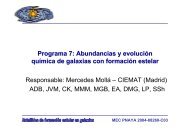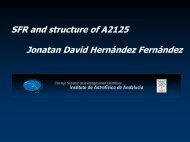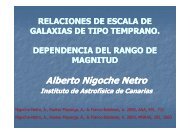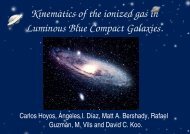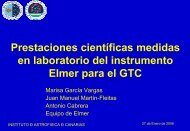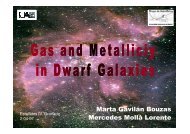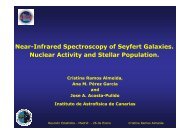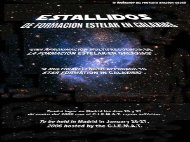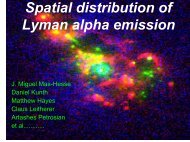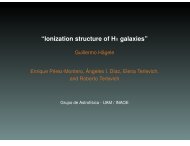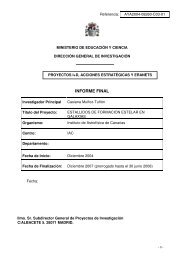Seyfert 2 galaxy NGC 1808
XMM-Newton Observation of the Seyfert 2 galaxy NGC 1808
XMM-Newton Observation of the Seyfert 2 galaxy NGC 1808
- No tags were found...
Create successful ePaper yourself
Turn your PDF publications into a flip-book with our unique Google optimized e-Paper software.
XMM-Newton Observation of the<br />
<strong>Seyfert</strong> 2 <strong>galaxy</strong> <strong>NGC</strong> <strong>1808</strong><br />
Elena Jiménez Bailón<br />
XMM-Newton SOC-ESA<br />
Collaborators:<br />
María Santos Lleó<br />
Michael Dahlem<br />
Jose Miguel Mas Hesse<br />
Matthias Ehle<br />
Matteo Guainazzi<br />
Tim Heckman<br />
Kim Weaver
Introduction<br />
X-ray Emission Sources (I)<br />
• Emission of AGNs<br />
-L ~ 10 38-43 erg/s<br />
- Power law F ν<br />
=ν α , α=0.7-1.2 Reeves,00<br />
- Absorbing material (torus, accretion disk, …)<br />
- Variability<br />
• Emission of Binary Systems<br />
-L ~ 10 37-38 erg/s<br />
- Depends on the nature of the compact object and the kind of accretion<br />
• Diffuse Emission of the Hot Gas<br />
- Temperature of the hot gas T~10 7 K<br />
- Significant Contribution of the young stellar regions at < 1 keV<br />
• Interaction of IR photons with e - of SN
Introduction<br />
X-ray Emission Sources (II)<br />
• Emission of SNR<br />
-L ~ 10 37 erg/s<br />
- Significant contribution at < 2 keV<br />
• Emission of Individual Stars<br />
-L ~ 10 32-33 erg/s<br />
• Emission of Ultraluminous X-ray sources (ULX)<br />
-L ≥ 10 39 erg/s<br />
- Yet unknown origin
General Properties of <strong>NGC</strong> <strong>1808</strong><br />
<strong>NGC</strong> <strong>1808</strong><br />
• Spiral SBC<br />
• D = 10.9 Mpc 1″ ≡53 pc<br />
• Central 1 kpc:<br />
- HII regions<br />
-SNR<br />
- Intense star-forming regions
General Properties of <strong>NGC</strong> <strong>1808</strong><br />
<strong>NGC</strong> <strong>1808</strong><br />
Nuclear Activity<br />
• <strong>Seyfert</strong> 2 or Starburst <strong>galaxy</strong><br />
• IR emission suggests the presence of<br />
star formation + additional source<br />
• X-ray suggest a mixed origin:<br />
star formation + additional source<br />
WFPC2 2x2 kpc 2
X-ray emission<br />
EPIC<br />
OM<br />
RGS
Morphology of the X-ray Emission<br />
EPIC pn-MOS Imaging
Nuclear X-ray Emission<br />
Morphology of the emission<br />
• The spectra of the outer regions are<br />
similar<br />
• A main part of the hard X-ray<br />
emission is originated in the nucleus<br />
• The nuclear X-ray emission is harder<br />
Region 1<br />
Region 2<br />
Region 3<br />
Region 4<br />
r = 16´´ (850 pc)<br />
r = 35´´ (1.9 kpc)<br />
r = 2´ (6.4 kpc)<br />
r = 20´´- 50´´ (1-2.7 kpc)
Morphology of the X-ray Emission<br />
<strong>NGC</strong> <strong>1808</strong><br />
• Extended emission<br />
• Ultraluminous point-like X-ray sources<br />
in the central 600 pc<br />
L 2-10 keV<br />
~10 39 erg/s Zezas, 01
Spectral Analysis of the X-ray Emission<br />
Nuclear region r = 850 pc<br />
Γ = 0.86±0.07<br />
kT = 0.58 +0.02 -0.07 keV T = 6.6+0.2 -0.6 ×106 K<br />
[Ne]=1.5 +0.9 -0.6 [Mg]=2.0+0.9 -0.6 [Si]=1.6+0.9 -0.6<br />
[Fe]=0.6 +0.2 -0.1<br />
χ 2 ν<br />
= 1.13 with 94 degrees of freedom<br />
25 % Power law<br />
L 0.23-2keV = 1.6±0.3×10 40 erg/s<br />
75 % Mekal<br />
98 % Power law<br />
L 2-10keV = 1.55±0.07×10 40 erg/s<br />
2 % Mekal
Spectral Analysis of the X-ray Emission<br />
Analysis of the high resolution X-ray spectrum<br />
The high resolution spectrum obtained with RGS in very similar to the one<br />
obtained for M82
Spectral Analysis of the X-ray Emission<br />
Analysis of the high resolution X-ray spectrum (II)<br />
Simultaneous analysis PN y RGS<br />
Power law + 13 emission lines of Si, Mg, Ne, Fe and O<br />
Temperature, luminosity and ratios between emission lines are<br />
consistent with a being originated in a collisionally ionized plasma<br />
associated to SFR which dominates the total soft X-ray spectrum
Results on the Analysis of the X-ray Emission<br />
• Morphology of the X-ray emission<br />
- Extended emission<br />
- Unresolved source in hard X-rays<br />
• Spectrum of the extended region:<br />
- Thermal emission Related to the SF processes<br />
• Nuclear spectrum:<br />
- Power law + thermal component<br />
- Index of the power law<br />
Γ(<strong>NGC</strong> <strong>1808</strong>)=0.9 lower than in active galaxies<br />
- Luminosity compatible with <strong>Seyfert</strong> 2 and LINERS or<br />
an ultraluminous X ray source (ULX)<br />
The study of the X-ray nuclear emission suggests the coexistence of an<br />
active galactic nuclei (or an ULX) and star formation regions
Analysis of the optical-UV Emission<br />
<strong>NGC</strong> <strong>1808</strong><br />
• Star forming regions<br />
are located in the<br />
spiral arms and bar<br />
• Correlation between<br />
UV and X-rays
Analysis of the optical-UV Emission<br />
<strong>NGC</strong> <strong>1808</strong><br />
X-rays BLUE<br />
UV emission GREEN<br />
Hα emission RED
Conclusions<br />
• The spectral analysis of the EPIC spectra shows that the emission<br />
of the point-like source is dominated by hot gas in soft X-rays,<br />
but an additional source is producing most of the hard<br />
X-ray emission<br />
• The emission of the hard X-ray point-like source is consistent with<br />
the presence of an active galactic nucleus, but it is not possible<br />
to rule out other possibilities (ULX)




